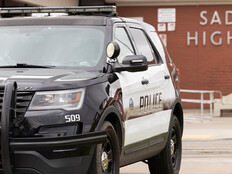To address the rising tide of school violence, K–12 school districts need advanced security technologies to augment their thinly stretched staffs. Upgrading physical security, prevention, cybersecurity and emotional wellness solutions — which constitute the four pillars of physical safety — can protect staff and students.
Unfortunately, physical safety solutions, especially those that connect to a district’s network or integrate artificial intelligence, can be costly for K–12 districts. For those schools whose budgets can’t support the needed safety upgrades, grant funding can help fill the gaps.
Federal funding in particular can bridge the financial gap but only if schools know where to find it and how to apply.
Click the banner for physical safety resources for your K–12 school.
What Is the COPS SVPP Grant?
The School Violence Prevention Program (SVPP) is funding awarded by the Department of Justice’s Office of Community Oriented Policing Services (COPS).
The organization awards millions of dollars in grant funding to public entities, such as K–12 public schools and state and local law enforcement agencies, each year. In 2023, SVPP allocated $73 million in funding, with districts receiving up to $500,000 in grants to help upgrade their physical security systems. The two-part 2024 deadline is fast approaching, with applications due on June 11 and June 17.
How Does COPS SVPP Work to Support K–12 Schools?
The COPS SVPP aims to improve school security through evidence-based programs and technology. School safety experts laud the program as an important resource for schools looking to address security concerns.
“It’s great that there is grant-funded support for the purpose of preventing violence in our schools,” says Amanda Klinger, director of operations at the Educator’s School Safety Network. “Anything we do to improve safety in our schools is a step in the right direction.”
EXPLORE: Experts discuss the importance of stakeholder collaboration for school safety.
South Carolina’s Lexington County School District 3 secured the maximum grant amount in 2023, which will benefit its 2,000 students across five schools. “We are a small district,” says COO Todd Bedenbaugh. “We are dependent on grants to improve our whole school system, and this will enable us to improve our safety.”
What School Safety Technologies Are Covered Under COPS SVPP?
Schools can leverage COPS SVPP funding to purchase metal detectors, locks, lighting and other deterrents. They can spend the money on “technology for expedited notification of local law enforcement during an emergency,” as well as other measures that COPS deems a significant improvement in security, DOJ notes.
Montana’s Havre Public Schools, for example, is looking at using the COPS grant to update paging and emergency management systems, and signage in the building.
Lexington County School District 3 is upgrading its cameras, going from black-and-white to color, with new cameras in the parking lots, a front-door camera system and centralized controls. But with every new camera, more data is created, Bedenbaugh notes, so the district is also investing in new infrastructure. “There will be a dedicated server just for our cameras,” he says.
The district is also putting modernized locks on the doors. “With the old system, you had to have a key,” Bedenbaugh says. But with the new equipment, “we can lock down all of our doors, and we’ll be able to do everything electronically. At the school level, the principal or assistant principal will be able to do that from their phones. If they’re in a different part of the building, they can go in lockdown mode.”
K–12 schools can also leverage SVPP funding to upgrade and modernize their automated alert systems. “It’s a really helpful thing to be able to quickly provide useful information to students’ parents: ‘Here’s what’s happening, here’s what we need you to do,’” Klinger says.
Schools can also use the grant to fund entry control and emergency notification systems. They can buy intercom systems, video surveillance technology and ID scanning devices. SVPP also supports the purchase of two-way radios and other physical security solutions. DOJ lists a range of potential uses for the grant money and covers up to 75 percent of the cost of upgrades, with schools and districts paying the rest.
KEEP READING: Rural and urban schools secure funds differently for physical safety.












